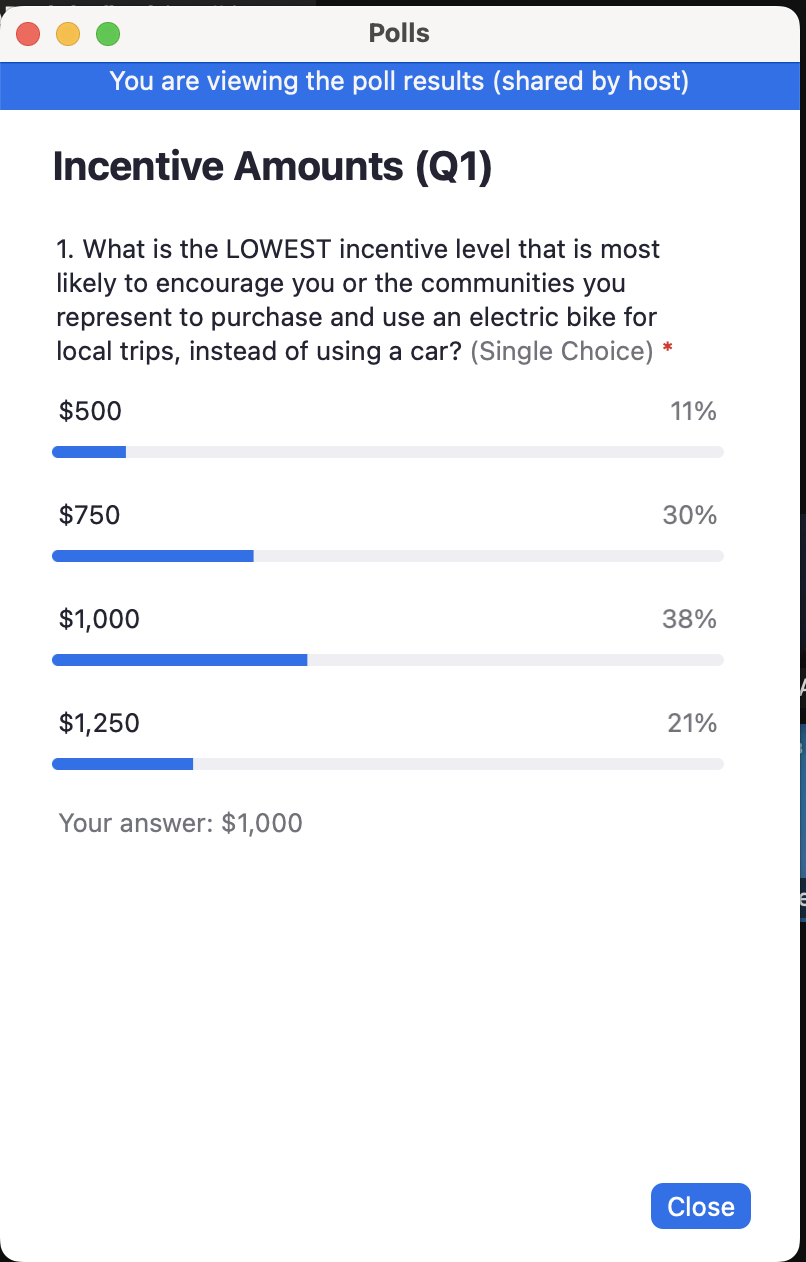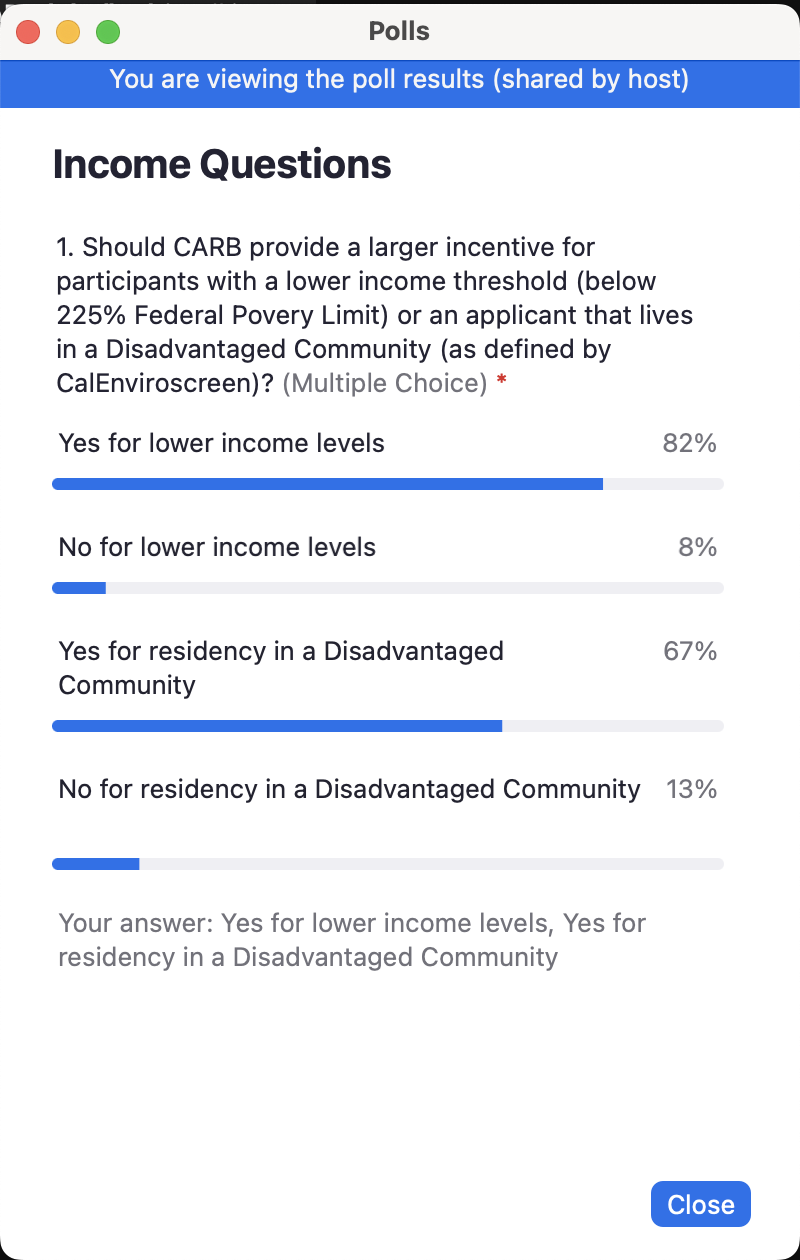CARB Electric Bicycle Incentives Project Work Group Report Back: September 28, 2022
On September 28, 2022, the California Air Resources Board held a follow-up meeting of the Electric Bicycle Incentives Project work group to continue the discussion from the August meeting on the pilot of the statewide e-bike voucher program, which will launch in 2023. Participants weighed in on what types of e-bikes should qualify, how to distribute the funds equitably, incentive amounts and more.
Like the previous meeting in August, the session was well-attended, with almost 200 participants signing on to ask questions, participate in polling, and provide feedback on aspects of the program. Thank you to everyone who came and gave input. You are helping to make this a better program!
A poll on the base amount for the incentive showed that most participants want a higher amount than the $750 proposed by CARB. However, for this session, most of the discussion focused on which e-bikes should qualify and how to ensure that the funds are distributed as equitably as possible.
Incentive amounts polling for September 2022 CARB e-bike work group meeting



Class 3 e-bikes are transportation
California breaks e-bikes into three classifications:
- Class 1: speed limited to 20 mph, pedal assist only
- Class 2: speed limited to 20 mph, pedal assist and throttle
- Class 3: speed limited to 28 mph, pedal assist only
The same rules that apply to standard bikes apply to Class 1 and 2 e-bikes, but Class 3 e-bikes have additional restrictions: You have to be at least 16 to operate one, and riders of all ages must wear a helmet.
CARB had proposed allowing recipients to use incentives to buy only Class 1 and 2 e-bikes, but participants in the work group meeting made an excellent case for making Class 3 e-bikes eligible.
Reasons to support Class 3 e-bike purchases include:
- The speed limitation is somewhat meaningless since people on non-electric bikes can and do ride faster than 20 mph.
- The higher speed makes it safer for people to mix with car traffic in areas that have inadequate bike infrastructure.
- The higher speed could be essential for people with longer commutes.
CARB program managers at the meeting indicated that they are open to expanding which bikes qualify and will likely include Class 3 e-bikes, based on the solid support at the work group.
Building equity into a state grant program
The work group included extensive comments and calls to distribute the $10 million in e-bike vouchers equitably. California’s experience with electric vehicle (EV) rebates, which went to buyers who were wealthier and Whiter than the average Californian in the program’s initial year, informed the discussion. EV programs for low-income buyers have failed to serve low-income Californians. Some work group participants voiced a desire to avoid those shortfalls with the e-bike incentives program, stating that equity was a paramount goal. In contrast, others noted that, if the goal is to reduce carbon emissions from car travel, recipients’ income level is less critical than how many car trips the e-bike will replace.
The program is structured with low-income recipients in mind, offering upfront vouchers rather than after-purchase rebates, which don’t help the people who need extra funds to be able to make a purchase. And CARB will limit eligibility to people earning 400% of the federal poverty level or less. However, the program is currently structured as first-come, first-served, which can give an edge to applicants with more connections and resources. Participants at the meeting expressed a strong desire to see CARB do better with the administration of this program, and there was discussion of switching to a needs-based application process.
If CARB moves to a needs-based approach, the program launch may be delayed because it will take longer to put systems into place to facilitate that process.
At CalBike, we feel that a crucial component of equity in incentive distribution is to leverage community-based organizations to help spread the word and assist their constituents in accessing and completing the application process, as well as choosing and maintaining their e-bikes. CARB currently has a CBO network through its electric vehicle incentives programs, but CalBike will work with the agency to encourage them to add bicycle-specific CBOs specifically to help with this e-bike program.
Eligible e-bike retailers
The work group discussed where incentive recipients should be able to buy e-bikes through the program. Concerns raised included ensuring that local bike shops can get parts from manufacturers to service the bikes bought through the program, even if people purchase them online.
Once the administrator is in place, it will set a process for retailers to apply to participate in the program based on criteria set by CARB. CalBike is following this discussion closely and plans to offer more resources for e-bike retailers soon.
A transparent process
At CalBike, we’ve been getting a lot of questions about the e-bike incentives program, so we created FAQs to answer some of them. We’re also engaging with CARB outside the work group meetings to encourage them to bring more transparency to the launch of the e-bike program. For more information about California’s e-bike incentives program, sign up for our e-bike interest list and view a meeting recording below.





